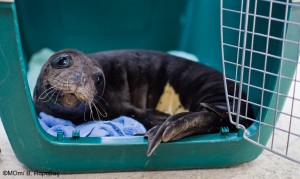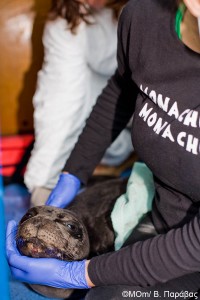Press Release | MOm
 An orphaned new-born Monachus monachus was found stranded late in the afternoon of Wednesday 14th of October, at the beach of Assos in Kefalonia island, by local residents. MOm’s Rescue team travelled immediately to the area and examined the 10 day female pup that was still alone at the beach, lost from its mother following the severe storms of the last few days. The animal was found dehydrated and had visible injuries on its body, probably form the wave action on the rocky coast. MOm is the Greek NGO working actively, over the last decades, to conserve the Mediterranean monk seal, a critically endangered species with less than 600 individuals remaining throughout the world
An orphaned new-born Monachus monachus was found stranded late in the afternoon of Wednesday 14th of October, at the beach of Assos in Kefalonia island, by local residents. MOm’s Rescue team travelled immediately to the area and examined the 10 day female pup that was still alone at the beach, lost from its mother following the severe storms of the last few days. The animal was found dehydrated and had visible injuries on its body, probably form the wave action on the rocky coast. MOm is the Greek NGO working actively, over the last decades, to conserve the Mediterranean monk seal, a critically endangered species with less than 600 individuals remaining throughout the world
The young seal was named “Nefeli” by the local residents and volunteers, that found her helpless and stood guard overnight, until MOm’s team arrived to the area. MOm’s specialists provided first aid to Nefeli and, assisted by the Port Police officers of Fiskardo, prepared the pup for its immediate and safe transportation to the Rescue and Rehabilitation Centre of MOm at Steni Vala, Alonissos, within the National Marine Park of Alonnisos, Northern Sporades.
Upon its arrival at MOm’s Rescue and Rehabilitation Centre and the completion of the first veterinary tests, MOm’s staff, in collaboration with the Veterinary School of the University of Thessaloniki, will put Nefeli in an intensive veterinary therapy and rehabilitation program, The first critical phase includes the gradual provision of fish porridge, as there is still no substitute of maternal milk for the Mediterranean monk seal.
 The treatment and rehabilitation program of a Mediterranean monk seal pup lasts approximately 5 months and if it is completed successfully the animal is released healthy back to its natural environment. The complete rescue, treatment and rehabilitation procedures all follow strict international protocols. The whole process is long and demanding for both Nefeli and the people involved, with several tests, continuous treatment, around the clock feedings and hard physical work. But MOm’s specialized personnel, the various expert collaborators and especially the volunteers assisting, are all optimistic and determined to make their best to see Nefeli healthy.
The treatment and rehabilitation program of a Mediterranean monk seal pup lasts approximately 5 months and if it is completed successfully the animal is released healthy back to its natural environment. The complete rescue, treatment and rehabilitation procedures all follow strict international protocols. The whole process is long and demanding for both Nefeli and the people involved, with several tests, continuous treatment, around the clock feedings and hard physical work. But MOm’s specialized personnel, the various expert collaborators and especially the volunteers assisting, are all optimistic and determined to make their best to see Nefeli healthy.
MOm would like to thank the Port Police Authority of Fiskardo and all the local supporters for their valuable contribution in the effort to rescue the new-born monk seal pup.
If you would like to support Nefeli’s rescue and treatment program, do visit MOm’s site www.mom.gr.


 Molokai residents flew to Oahu to protest a federal agency’s removal of a nearly blind Hawaiian monk seal from waters off Kaunakakai.
Molokai residents flew to Oahu to protest a federal agency’s removal of a nearly blind Hawaiian monk seal from waters off Kaunakakai. The first Hawaiian monk seal successfully raised from birth in captivity was diagnosed with cataracts after being plucked from Kaunakakai Harbor on Friday, which means he won’t be going back to the wild.
The first Hawaiian monk seal successfully raised from birth in captivity was diagnosed with cataracts after being plucked from Kaunakakai Harbor on Friday, which means he won’t be going back to the wild. An orphaned new-born Monachus monachus was found stranded late in the afternoon of Wednesday 14th of October, at the beach of Assos in Kefalonia island, by local residents. MOm’s Rescue team travelled immediately to the area and examined the 10 day female pup that was still alone at the beach, lost from its mother following the severe storms of the last few days. The animal was found dehydrated and had visible injuries on its body, probably form the wave action on the rocky coast.
An orphaned new-born Monachus monachus was found stranded late in the afternoon of Wednesday 14th of October, at the beach of Assos in Kefalonia island, by local residents. MOm’s Rescue team travelled immediately to the area and examined the 10 day female pup that was still alone at the beach, lost from its mother following the severe storms of the last few days. The animal was found dehydrated and had visible injuries on its body, probably form the wave action on the rocky coast.  The treatment and rehabilitation program of a Mediterranean monk seal pup lasts approximately 5 months and if it is completed successfully the animal is released healthy back to its natural environment. The complete rescue, treatment and rehabilitation procedures all follow strict international protocols. The whole process is long and demanding for both Nefeli and the people involved, with several tests, continuous treatment, around the clock feedings and hard physical work. But MOm’s specialized personnel, the various expert collaborators and especially the volunteers assisting, are all optimistic and determined to make their best to see Nefeli healthy.
The treatment and rehabilitation program of a Mediterranean monk seal pup lasts approximately 5 months and if it is completed successfully the animal is released healthy back to its natural environment. The complete rescue, treatment and rehabilitation procedures all follow strict international protocols. The whole process is long and demanding for both Nefeli and the people involved, with several tests, continuous treatment, around the clock feedings and hard physical work. But MOm’s specialized personnel, the various expert collaborators and especially the volunteers assisting, are all optimistic and determined to make their best to see Nefeli healthy.